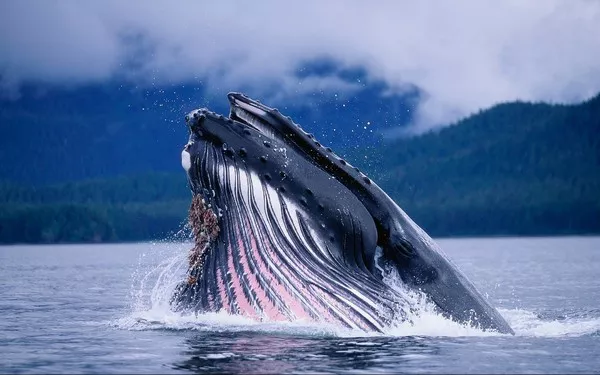In the rich tapestry of Earth’s biodiversity, mammals stand out as a diverse and fascinating group of creatures, ranging from the diminutive bumblebee bat to the colossal blue whale. Among these remarkable beings are the true titans of the animal kingdom—the heaviest mammals on the planet. In this comprehensive exploration, we delve into the lives of the top three heaviest mammals, uncovering the awe-inspiring adaptations that allow them to dominate their respective habitats.
Top 3 Heaviest Mammals on Earth
1. Blue Whale (Balaenoptera musculus)
Weight: Up to 200 tons
The blue whale reigns supreme as the undisputed heavyweight champion of the animal kingdom. With a weight that can exceed 200 tons (equivalent to approximately 441,000 pounds), these majestic marine mammals are the largest animals to have ever lived on Earth.
Blue whales inhabit the world’s oceans, traversing vast distances in search of their primary prey—krill. Despite their massive size, they sustain themselves on these tiny crustaceans, filtering thousands of gallons of seawater through baleen plates in their mouths to capture their minuscule prey.
What sets the blue whale apart in terms of sheer mass? One key factor is their incredible size, which is facilitated by their streamlined bodies and efficient buoyancy control. Blue whales possess a layer of blubber that can measure up to a foot thick, providing insulation against the cold temperatures of the ocean depths and serving as an energy reserve during long migrations and periods of fasting.
Furthermore, blue whales exhibit unique feeding behaviors, such as lunge feeding, in which they engulf large volumes of water and krill in a single gulp. This efficient feeding strategy allows them to maximize their energy intake while minimizing the effort required to capture their prey.
Despite their impressive size, blue whales face numerous threats, including ship strikes, entanglement in fishing gear, and habitat degradation due to human activities such as pollution and climate change. Conservation efforts aimed at protecting their feeding grounds, reducing anthropogenic disturbances, and promoting sustainable fishing practices are crucial for ensuring the continued survival of these magnificent creatures.
2. African Elephant (Loxodonta africana)
Weight: Up to 12 tons
As the largest land animals on Earth, African elephants command awe and reverence wherever they roam. With a weight that can exceed 12 tons (equivalent to approximately 26,000 pounds), these majestic pachyderms are icons of strength, resilience, and familial bonds.
African elephants inhabit a range of habitats across sub-Saharan Africa, from dense forests to open savannas. They are highly social animals, living in tight-knit family groups led by matriarchs—experienced females who guide their herds in search of food, water, and shelter.
What makes African elephants among the heaviest mammals on Earth? Their impressive bulk is primarily attributed to their large body size and thick, muscular build. Male elephants, known as bulls, are particularly massive, with thick necks, powerful tusks, and robust frames that enable them to assert dominance and compete for mating opportunities.
Furthermore, African elephants possess remarkable adaptations for survival in their diverse habitats, including elongated trunks for grasping food and water, massive ears for dissipating heat, and complex social structures that facilitate communication and cooperation within their herds.
Despite their formidable size, African elephants face numerous threats to their existence, including habitat loss, poaching for ivory, and human-wildlife conflict. Conservation efforts aimed at protecting their habitats, combating poaching, and promoting coexistence with local communities are essential for ensuring the long-term survival of these iconic animals.
3. Hippopotamus (Hippopotamus amphibius)
Weight: Up to 4.5 tons
The hippopotamus, often referred to as the “river horse,” is a formidable presence in the waterways of sub-Saharan Africa. With a weight that can exceed 4.5 tons (equivalent to approximately 9,900 pounds), these semi-aquatic mammals are among the heaviest land animals on Earth.
Hippopotamuses spend much of their time submerged in rivers, lakes, and swamps, emerging at night to graze on grasses and other vegetation along the water’s edge. Despite their herbivorous diet, they possess formidable tusks and powerful jaws capable of inflicting serious injuries on potential predators and rivals.
What makes hippopotamuses so heavy? Their impressive bulk is primarily due to their dense, muscular bodies and thick skin, which provide protection against the sun’s harsh rays and potential predators. Additionally, hippopotamuses possess adaptations for buoyancy and efficient movement in water, including dense bones that help them remain submerged while grazing and powerful limbs for propulsion and steering.
Despite their formidable size and seemingly placid demeanor, hippopotamuses are among the most dangerous animals in Africa, responsible for more human deaths each year than any other large mammal on the continent. Encounters between humans and hippos can result in injuries or fatalities, highlighting the importance of respecting their space and habitat.
Conservation efforts aimed at protecting hippopotamus habitats, mitigating human-wildlife conflicts, and promoting coexistence with local communities are essential for ensuring the continued survival of these iconic and enigmatic creatures.
In conclusion, the top three heaviest mammals on Earth represent a diverse array of species, each with its own unique adaptations and ecological roles. From the vast expanses of the ocean to the grassy plains of Africa, these magnificent creatures inspire awe and wonder in all who encounter them. By studying their biology and behavior, we gain valuable insights into the intricate web of life that sustains our planet and the importance of conserving Earth’s most remarkable inhabitants for generations to come.
You Might Be Interested In:



























